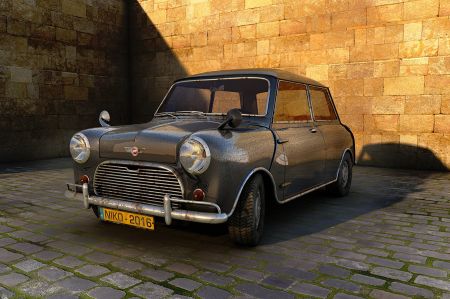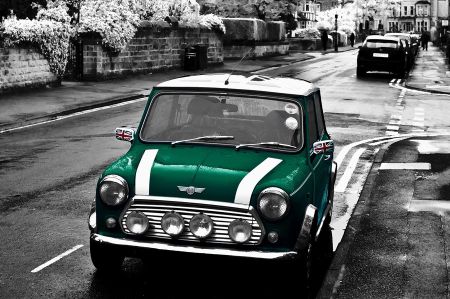The Greek Konstantin Issigonis and his Bavarian wife Hulda Prokopp left their Greek home island of Paros at the end of the 18th century in order to run a machine factory in the city of Smyrna, today's Izmir.
Just a few years later, on November 18, 1906, the son of Alexander Arnold Constantine Issigonis was born in the Issigonis family in Smyrna, which at the time belonged to the Ottoman Empire but was still strongly Greek. Alexander Issigonis, like many millions of other Greek-born citizens, had to flee the city of Smyrna and the country together with his family in September 1922 during the so-called "population exchange", also known as the "Asia Minor catastrophe". Alexander Issigonis came to England in this way on an English ship, his father died during the crossing.
Austin Motor Company, Morris Motor Company and British Leyland
Probably due to his father's business, Alexander Issigonis developed a great talent and fondness for technical details and connections early on. After being forced to come to England, he decided to join the slowly booming car industry and become a car designer. He studied at Battersea Polytechnic School in London, which he was unable to complete successfully despite three years of study. To earn a living, Alexander Issigonis worked in various drawing and design offices until he received a job offer from the design department of the Morris company. Although there was a short stopover at the then very posh car brand Alvis, Issigonis found his “home” at Morris.
 Morris was already a well-known car brand at the beginning of the 1920s, which later merged with Austin (who doesn't know the notorious Austin Healey) to form BMC. The big breakthrough for Issigonis came with the development of the Morris Minor (1948 - 1971) and the legendary cult car Austin "Mini" (1959 - 2000). For the first time in the history of automobile construction, the engine was installed transversely in the Mini, marking the beginning of the era of transverse front engines. From 1959 onwards, the Mini was successfully built and marketed by the Austin Motor Company and the Morris Motor Company, later also by British Leyland and Rover or their license partners, such as Innocenti, until the year 2000.
Morris was already a well-known car brand at the beginning of the 1920s, which later merged with Austin (who doesn't know the notorious Austin Healey) to form BMC. The big breakthrough for Issigonis came with the development of the Morris Minor (1948 - 1971) and the legendary cult car Austin "Mini" (1959 - 2000). For the first time in the history of automobile construction, the engine was installed transversely in the Mini, marking the beginning of the era of transverse front engines. From 1959 onwards, the Mini was successfully built and marketed by the Austin Motor Company and the Morris Motor Company, later also by British Leyland and Rover or their license partners, such as Innocenti, until the year 2000.
Ringo Starr also had a hatchback
 At that time, the Mini was a revolutionary and original small car, the main feature of which was the installation of the gearbox below the engine. Transmission and engine formed a unit that even shared the lubricant. Absolutely new in automotive engineering. Due to these technical features and because of the small wheels of only 10 inches with a short body overhang, a vehicle length of just over three meters was possible. The impetus for the development of a small and therefore energy-saving car lay in the Suez crisis of 1956, which first showed the consequences of dependence on crude oil with its noticeable effects on Europe. The first vehicles of this type were manufactured in Birmingham and rolled off the assembly line on August 18, 1959.
At that time, the Mini was a revolutionary and original small car, the main feature of which was the installation of the gearbox below the engine. Transmission and engine formed a unit that even shared the lubricant. Absolutely new in automotive engineering. Due to these technical features and because of the small wheels of only 10 inches with a short body overhang, a vehicle length of just over three meters was possible. The impetus for the development of a small and therefore energy-saving car lay in the Suez crisis of 1956, which first showed the consequences of dependence on crude oil with its noticeable effects on Europe. The first vehicles of this type were manufactured in Birmingham and rolled off the assembly line on August 18, 1959.
In recognition of his achievements in the automotive industry, Alexander Issigonis was knighted and was allowed to call himself Sir Alex Issigonis from then on. Despite his retirement in 1971, Issigonis continued to work on technical developments of his vehicles until his death on 2 October 1988 in Longbridge. The name and stylistic features of the Mini were then transferred to the BMW brand in 2001, which managed to continue the success of this small car.
The Mini had already achieved cult status in the early 1960s. A large number of celebrities used or owned one or more Minis: Twiggy, Mary Quant, Peter Sellers or the Beatles, who owned 4 Minis alone. Ringo Starr even had a hatchback with a large tailgate so that he could also transport his drum kit. Peter Sellers gave his wife Britt Ekland one of the first Hatchback Minis. The legendary singer of the band T.Rex, Marc Bolan, even died in his Clubman 1275 GT in a tragic traffic accident. Even the English queen was occasionally chauffeured in the Mini. And who doesn't know the famous Mr. Bean alias Rowan Atkinson, who liked to add a mini to his films, which sometimes even played a leading role. In Germany, too, the car became a cult. For the 35th anniversary, Marius Müller-Westernhagen bought the special version of a green Mini 35.
Enzo Ferrari owned three Minis and is said to have coined the saying: "If he weren't so ugly - I could fall in love with the Mini."
Please read as well:
The Vitra site in Weil – exciting architecture
Heinrich on Tour - Preparations are running at full speed


